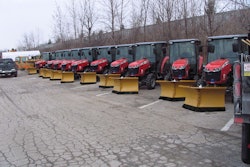 Bucket teeth
Bucket teethPhoto: Arrow Material Handling Products
One foot on the top of the bucket, the other in the cab, turn around, roll cage down, take a seat, parking break off, ignition engaged, you peer out over the edge of the bucket…dang. There it is.
The cutting edge of the bucket is curled back, worn out and ready to be replaced.
Sudden expenses are always frustrating, and this is no different. However, with better technique, a few industry tips and some preventative steps, forecasting future bucket issues will become easier and you can increase the lifespan of your bucket.
Proactive purchasing
The very best way to avoid unexpected bucket issues starts with the purchase process. Matching bucket capacity and size to the machine is critical to optimal bucket performance, as is quality materials and construction.
Choosing the right bucket
Bucket capacity:
Bucket width should be at least as wide as the outside width of the tires or tracks. If not, you will not be able to dig or scoop in one pass. The tires or tracks will ride on the material and the bucket will not remove that material. In contrast, buckets that exceed the capacity rating of the machine risk imbalance and tipping due to load size. In addition, larger buckets can handicap the operator’s vision if installed on a smaller machine.
Bucket construction:
Steel is important. The quality of the steel, the thickness of the steel and the process the steel goes through when being made are at the foundation of a good quality bucket. High-quality steel resists wear and lasts longer, increasing the lifespan and productivity of a bucket. Beyond the steel, there are both some design and reinforcement elements to look out for.
Bucket design:
Certain telltale design elements can be found on high-quality buckets that will indicate the longevity of the bucket design. Tubular construction of the upper lift and hardened edges are clear indicators the bucket in question was built to last. Also look for a radius bottom. This allows for material to curl at the back of the bucket, providing a more even load and increasing lifespan.
Bucket reinforcement:
In addition to the construction and design of the bucket, a variety of reinforcement plates are sometimes added to high-quality buckets to enhance durability. Look for reinforcement plates on the heel, sides and radius of the bucket. Skid plates are also sometimes added to the bottom of a bucket to reduce wear.
Choosing the right accessories
The cutting edge:
 Cutting edge
Cutting edgePhoto: Arrow Material Handling Products
The most common location of excessive wear on a skid steer bucket is at the cutting edge. When the cutting edge grinds against hard surfaces like asphalt or concrete, the center wears unevenly, resulting in a scallop shape.
Option 1: Weld-on cutting edge – Technically, every bucket comes with a weld-on cutting edge, however, when excessive wear causes the cutting edge to recede into the bucket, replacement can exceed the total cost of the bucket.
Option 2: Bolt-on reversible cutting edge – These replaceable cutting edges can be reversed before the edge scallops back into the bucket. Once both sides wear completely, the edge can be replaced.
Quick tip – Don’t try to reuse the bolts when reversing the bolt on edge, as the threads get damaged in use and the bolts won’t be reusable. Instead, just cut them off with a torch and replace.
Bucket teeth:
On tooth buckets, the tooth shank is welded to the weld-on cutting edge. Here, the use of a weld-on cutting edge is common because bucket teeth receive all the wear, therefore protecting the cutting edge. Bucket teeth attach by pin or crimp on to a shank. Pin on style teeth are typically recommended, as they are easy to change and are less likely to dislodge while in use. Regular inspection of these teeth is recommended. On a general purpose tooth, if the flat is missing or worn back to the shank, it needs to be replaced.
Quick tip – Don’t use a tooth bucket with missing teeth. This will wear out the shank and the tooth will not fit properly when replaced. It’s best to keep extra teeth on-hand and replace them as needed.
Maintenance and technique
Bucket inspections:
Inspections are critical to the ongoing upkeep and maintenance of both your machine and attachments. Being aware of cracks, stress fractures, excessive wear, loose hoses, dirt buildup in or around hydraulic fittings and damage to hydraulic hoses makes identifying and fixing future problems easier. The bucket coupler is the most commonly damaged part of the skid-steer bucket.
“This is where the bucket connects to the skid loader and requires a good solid fit,” says Scott Clevenger, vice president of sales at Arrow Acquisition LLC. “If cracked or extremely loose, don’t use it. Have a welder repair it or maybe it’s time for a new bucket. Don’t let mud or other debris build up in this area or in the pin holes at the bottom of the coupler. Keeping this area clean will only make your job a lot easier when it’s time to change out to a different attachment.”
When grading:
It’s all in the technique. Pressure is probably the most important factor when grading with a bucket. Too much pressure and you’ll find it hard to grade with any kind of finesse, also you’ll wear down the bottom of the bucket. Speed is also a factor. Grading too fast can cause unnecessary damage and wear due to collisions with unseen and sometimes immovable objects.
When back dragging:
Similar to grading, the pressure is key. Again, too much and this time the cutting edge will bear the brunt of the damage. A popular way around this snafu is to both practice and utilize your machine’s “float” function if equipped. The float function disables hydraulic flow to the vertical lift of your machine. This means the weight of both the arms and the bucket will fall to the ground allowing the bucket to move, or float, over the contours of the terrain. Keep the speed in check and avoid impact as much as possible.
EDITOR’S NOTE: This was written by Mitch Salva with Arrow Material Handling Products. Arrow Material Handling Products has been a leading supplier of replacement forks for over 40 years.









